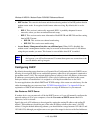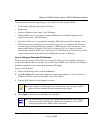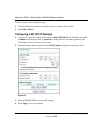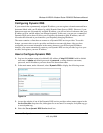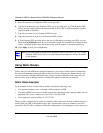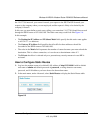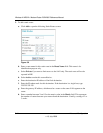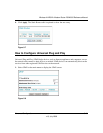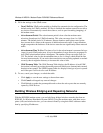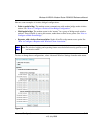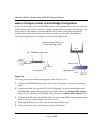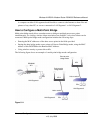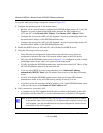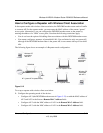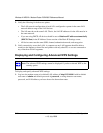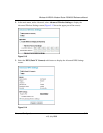
Wireless-N ADSL2+ Modem Router DGN2000 Reference Manual
5-14 Advanced Configuration
v1.0, July 2008
2. Fill in the settings on the UPnP screen:
• Turn UPnP On. UPnP can be enabled or disabled for automatic device configuration. The
default setting for UPnP is enabled. If UPnp is disabled, the modem router does not allow
any device to automatically control the resources, such as port forwarding (mapping), of
the modem router.
• Advertisement Period. The advertisement period is how often the modem router
advertises (broadcasts) its UPnP information. This value can range from 1 to 1440
minutes. The default period is 30 minutes. Shorter durations ensure that control points
have current device status at the expense of additional network traffic. Longer durations
might compromise the freshness of the device status but can significantly reduce network
traffic.
• Advertisement Time To Live. The time to live for the advertisement is measured in hops
(steps) for each UPnP packet sent. A hop is the number of steps allowed to propagate for
each UPnP advertisement before it disappears. The number of hops can range from 1 to
255. The default value for the advertisement time to live is 4 hops, which should be fine
for most home networks. If you notice that some devices are not being updated or reached
correctly, then it might be necessary to increase this value a little.
• UPnP Portmap Table. The UPnP Portmap Table displays the IP address of each UPnP
device that is currently accessing the modem router and which ports (internal and external)
that device has opened. The UPnP Portmap Table also displays what type of port is opened
and if that port is still active for each IP address.
3. To save, cancel your changes, or refresh the table:
• Click Apply to save the new settings to the modem router.
• Click Cancel to disregard any unsaved changes.
• Click Refresh to update the portmap table and to show the active ports that are currently
opened by UPnP devices.
Building Wireless Bridging and Repeating Networks
With the DGN2000 modem router, you can build large bridged wireless networks that form an
IEEE 802.11n Wireless Distribution System (WDS). Using the modem router with other access
points (APs) and wireless devices, you can connect clients by using their MAC addresses rather
than by specifying IP addresses.



